Blog # 1 `You shouldn’t take a picture. It’s a horrible building to live in.´
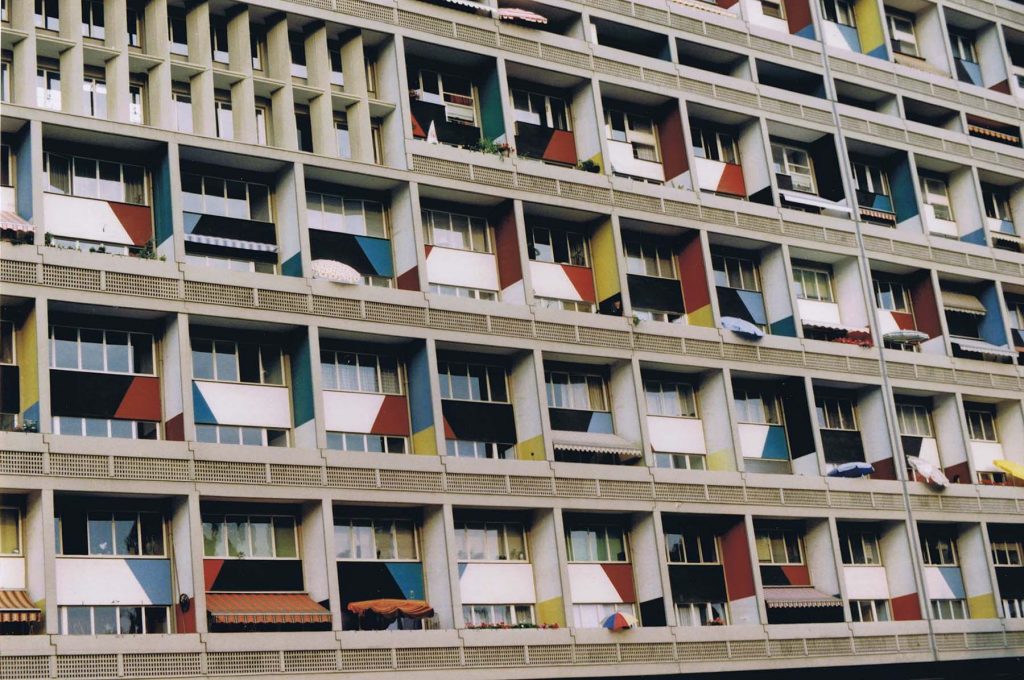
By Nadine Roos
It’s halfway in the nineties. We are on our second holiday together. Travelling through Europe with an interrail pass. We are both students and during our trip, we visit all the architectural masterpieces we have learned about.
Standing in front of the Corbusierhaus in Berlin we are approached by a tenant. To our surprise, he is very displeased with his home. He explains to us how unpleasant this architectural highlight is. We look at him as if he is a little crazy. Until then we had heard nothing but praise about Le Corbusier.
Years later, we visit another building by Le Corbusier. This time we are walking through Villa Savoye near Paris. Again we are surprised. We read that the Savoye family only lived here for a short period of time. The house was a nightmare to live in.
When is architecture good? When it follows a revolutionary new idea or when it is pleasant to be in? And can it be both?
Le Corbusier was a great and passionate designer. But the freedom he demanded for his own views and work became a restriction for the people who live and deal with his work on a daily basis. By sticking to his dogma he completely ignored if his buildings and urban structures were beneficial for tenants and users.
There is a contrast between theory and practice. Without theory, you can’t develop new practices. But too much theory becomes restrictive. This blog is our search for the right balance. We believe that cities should be contributing to the success and happiness of the people who live and work there. Attractive cities have successful people. These people live in neighbourhoods that contribute to their personal development. Those neighbourhoods are flexible and adaptive to new demands, wishes, insights, and dreams.
So we will be passionately searching for the right elements to make cities attractive.
Blog # 2 Falling in love and why cities are fantastic
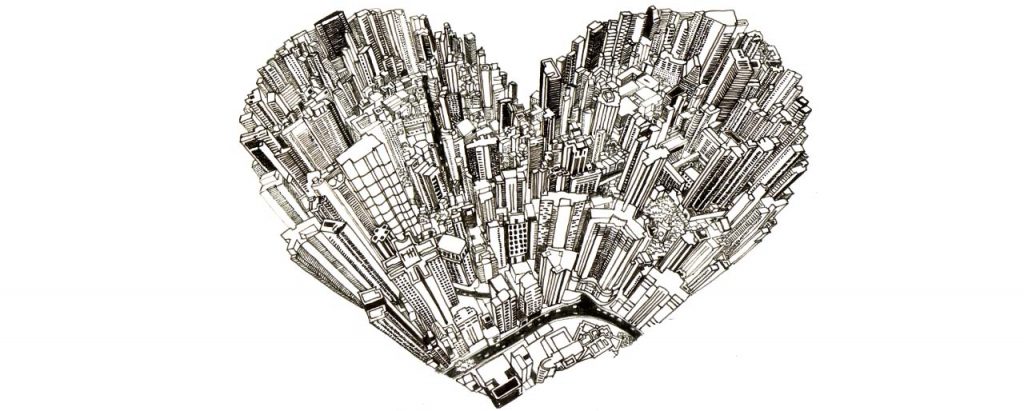
By Nadine Roos
We need love. We aren’t goldfish who can float solitary in a fishbowl and be perfectly fine. Without love, we waste away. Love gives you a warm feeling of security, but it also has these extra benefits.We flourish in a loving environment. We become happier and healthier. Being in a caring relationship brings financial benefits. Together you are smarter because two people know more than one, and problem-solving becomes easier. The strengthening and loving interaction between people also occurs between cities and urbanites.
A good city reinforces her citizens like a caring partner. Mutually citizens will treat their city with care. A city can bring out the best of people. This is an active process. Cities have to continuously work on their emotional connection with the urbanites. And that’s why I argue for seductive cities. Cities that are so attractive, that it will be impossible not to fall in love with them.
Within a relation, you have to work on keeping the spark alive. The relationship between city and urbanite also asks for a continuous loving maintenance. And if that goes well, the city offers a great life. There are multiple reasons why a relationship with a city is good for us. Hereunder, I will describe the six most important ones. The first three relate to the influence cities have on the working careers of urbanites, the last three describe the influence on our personal well-being.
#1 career developing
Our careers are important to us. They let us grow and develop. In a village the number of jobs and thus the career opportunities are limited. As a beginner, it is less easy to try a couple of jobs and to figure out which career fits you the best in a village. In a city, you can do that. You can switch work until you’ve found the perfect position. From there on you can start your development within your professional field.
#2 higher income
Money doesn’t make you happy, but worrying about it will make you unhappy. For our happiness in life, we are seeking for financial security. The chance to establish this is the highest in a city. At first glance, a city looks like a source of costs. Houses are expensive and you often have to pay for parking. But worldwide people get paid better in cities than in elsewhere. The difference is such, that despite the costs, it’s still lucrative to live in a city.
#3 concentration of intelligence
Imagine you have a plan. You have invented a product and you want to place it on the market. Most of us don’t have all the expertise to do this on our own. We need other people’s knowledge. The chance to find the right person to help you is bigger if you can search in a larger group than in a smaller one. Because this chance is highest in a city enterprising people tend to move to the city. This enlarges the chance to find the right business partner even more.
#4 marital market
How to find your ideal spouse? He or she must be somewhere. People move to the city in their search for a partner, because there are more people to pick from. And it’s possible to try something to see who will suit you best.
Evolutionary it is determined that women unconsciously tend to be attracted to successful men. As we´ve seen in #1 people who find their career important move to cities. So finding your successful man is easier in a city. Single twenty year old women flock to cities. Their percentage is much higher in cities as it is elsewhere.
#5 healthier life
Living in a city is healthier. Because urbanites walk and bike more. Outside the city, people use the car as their main means of transportation. And in the worse case scenario, something goes wrong and you are in desperate need of medical attention, the chance that you receive the right care is much bigger in a city. Each city has at least one hospital. Specialised medical care is within reach.
#6 better for the environment
The effect of our activities is expressed in our ecological footprint. The bigger the print the more destructive it is for the environment. Urbanites have on average a smaller ecological footprint than people elsewhere. Urbanites make lesser use of cars. They usually live in smaller houses, so they have to heat a lesser volume. Most urban dwellings are stacked next to and on top of each other. This also has a positive effect on reducing the amount of energy that is needed to heat the home. Urbanites, all living concentrated together, use less space in total as they would as if they all would live in a free-standing house. Therefore there is more space available for nature.
That we need love is clear. A loving connection strengthens us. So let’s all work together to boost the connection with our loved ones and our city.
For this blog, I have been inspired by the book ‘Welcome to the urban revolution’ by Jeb Brugmann
blog #3 The benefits of love and how cities make you live longer
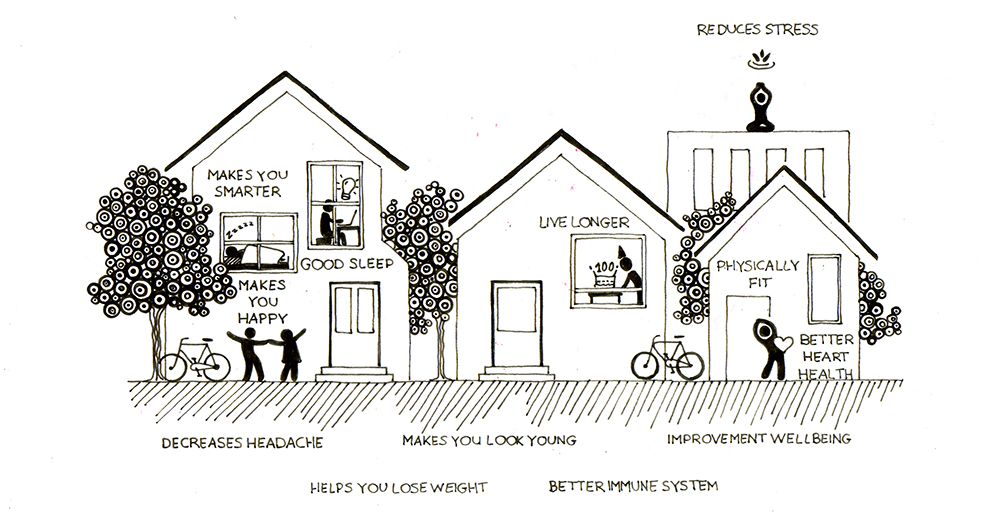
By Nadine Roos
Love is measurable. When we fall in love, the composition of our blood changes. The amount of the testosterone hormone decreases and the opposite happens with dopamine. We become more caring, happier and less stressed. When love is mutual and becomes a long-lasting warm relationship, it will have even more beneficial effects on you. Your immune system improves, it’s easier to keep a stable weight, and you’ll be fitter. These benefits have in the long run such a positive effect that people in a loving relationship, on average, become older than people without such a relationship.
A seductive city has the same effect on urbanites.
Choice between good and bad
We all want a longer and healthier life. But don’t just dive into a relationship or just start living in a city. A bad relationship will give you worrying troubles. You’ll sleep badly, headaches will press behind your eyes and your blood pressure will jump up. The ingredients to tackle your immune system. The same applies for bad cities. In a city that’s not good for its citizens, people will feel rushed. In a city that doesn’t offer any chances, poverty and despair will rise. And a city that doesn’t look attractive will take everybody along in its gloominess.
Active love
Find a partner and a city that fits you. One which will strengthen you. But once you’ve found it, it’s not ready yet. Cherish your partner. The same is true for the city. That’s why the city needs to be seductive and not only attractive. The city has to be more than a pretty picture. Continuously, she has to make sure urbanites stay in love with her. If that succeeds and the city makes sure you can reach your full potential than the dopamine in your blood will increase. At the same time, the city creates a sense of belonging. Your worries decrease and you’ll have a good night sleep. You wake up fit, keep a stable weight and become smarter. You are happier and look younger. All this together will result in you having a longer and happier life.
Next week: 10 tips for seductive cities
blog #4 How to become attractive? 10 tips for seductive cities.
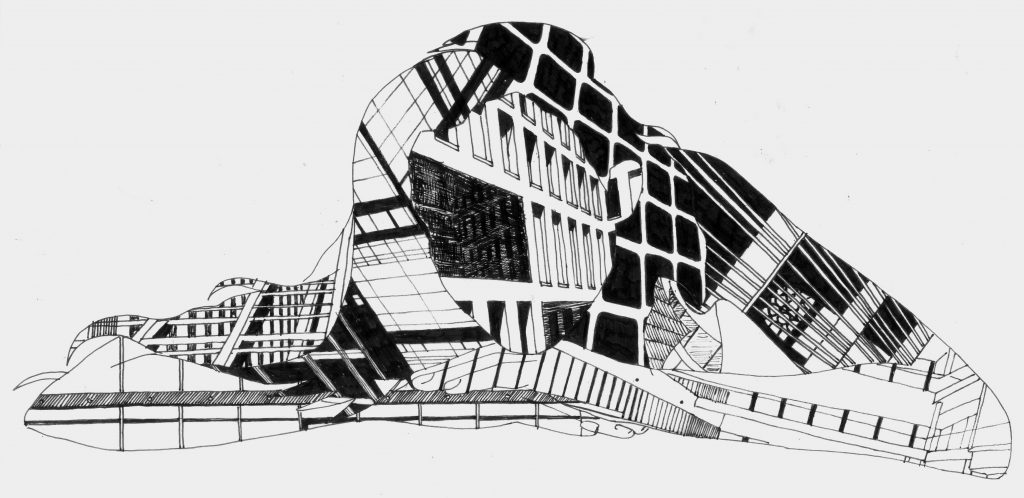
By Nadine Roos
# 1 look tempting
To be sexy, you need your own enticing style and don’t give away everything. Leave something to the imagination.
Seductive cities look amazing. The buildings are photogenic, the squares have an allure and the streets are inviting to stroll along. But a city can’t be captured at a glance. Wandering through the streets you can discover something interesting around each corner.
# 2 live healthy
Take good care of yourself. When you’re healthy, you radiant strength. A healthy city is in balance. She is resilient and doesn’t stand still. At the same time, the city takes care of the well-being of the urbanites. Living healthy is done on multiple levels. For example by exercising and by protecting against harmful elements. Cities where you can easily walk and bike keep you in good shape. Clean streets keep diseases at a bay. And all around the city, the air should be fresh. A lot of cities have work to do in this field to become seductive.
# 3 be playful
Seduce the other by impulsive, creative and crazy surprises. Show that you enjoy life. A desirable city is full of unexpected events. An afternoon in the city can take another direction by a spontaneous encounter. Street artists make you stop and let you be amazed. The city is a stage for everyone’s creativity.
# 4 stand tall
To create a good impression your posture is important. Stand tall and you’ll look confident. Cities reach for the sky. The taller the buildings, the more impressive the city. The skyline is visible from far away and attracts people.
# 5 keep it exciting
To gain the other’s love it’s important to be impulsive. Nothing so boring as predictability. A city that makes you fall in love shows each time a different side to discover. She is full of surprises and heeds the mood of the times. She is adventurous and a little naughty.
# 6 dance
Go crazy and seduce each other by dancing. Sensual from the hips or romantically close to each other. In a city that concurs you, it’s possible to dance to any kind of music. The rhythm takes you along to clubs in the late hours. Makes you forget everything during festivals. Or takes you spontaneously into her arms at a park or a square.
# 7 aphrodisiac
Strawberries dipped in chocolate, tinkling champagne, and adventurous oysters belong to the game of seduction. A seductive city offers all these treats. Sit down on a terrace or dive into one of the restaurants. It’s so pleasant to, once in a while, indulge yourself in all these delicious foods.
# 8 kick off your shoes and relax
It´s lovely to relax together and to do just nothing. Enjoying a lazy afternoon in the park. Spread a picnic blanket, kick off your shoes and let the grass tickle underneath your feet. Give each other a relaxing massage. Cities seduce you with their parks.
# 9 be yourself
Be authentic. Make sure you don’t dissolve in the crowd, but that you stay recognizable.
Cities need their own style. No two cities should look the same. A fantastic city does not only look significant, she also offers a place for birds of paradise, colourful characters and bon-vivants.
# 10 flirt and wink
In a seductive city, there is room for a quick flirtation. A sensual look and a brief caress. A city flirts with her tourists. Smiling together, they pose for a picture. They stroll along for hours. And they party until late at night. But after this casual adventure, suitcases are packed and the tourist goes home to his own city.

blog #5 Battling the environmental crisis; one flowerpot at a time
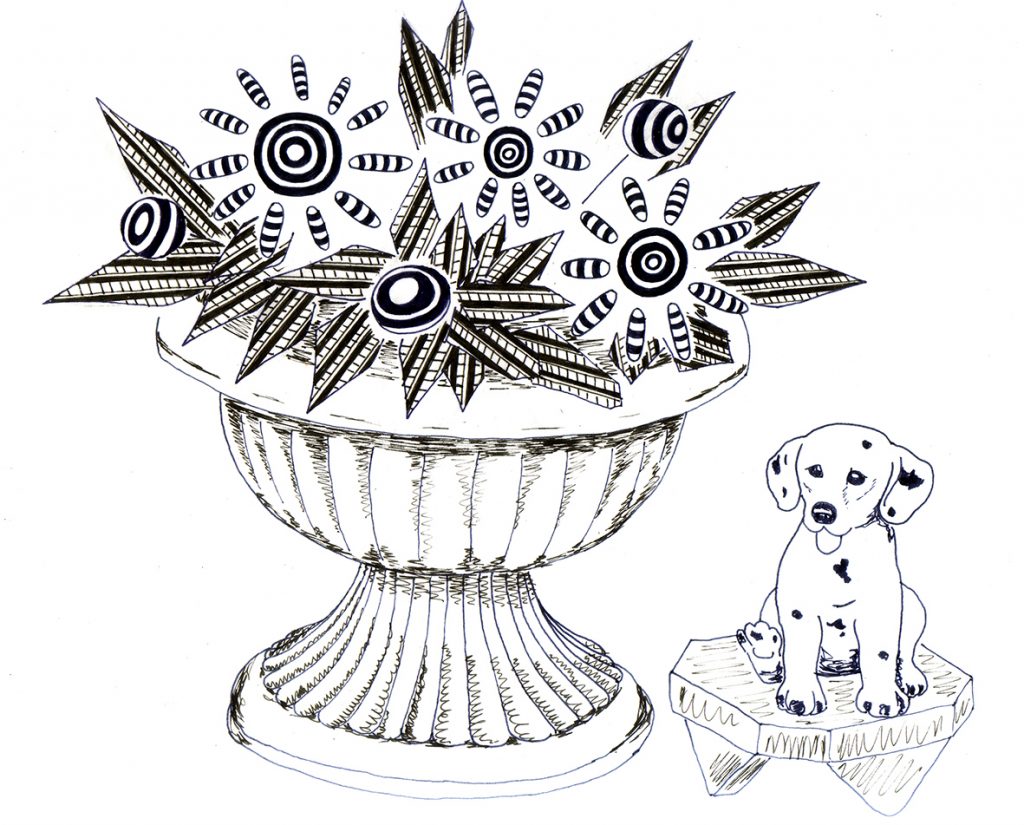
Nikki Daniëls & Nadine Roos
The global environmental crisis is about to threaten each and everyone of us. Natural disasters, economic stagnation, and natural resource shortages warn of a frightening future. The air in cities is polluted. Breathing is equal to smoking several cigarettes per day. That one short car ride doesn’t seem to matter that much, but all those car rides combined have catastrophic effects on our environment. Luckily, the opposite can be done as well. Every environmentally conscious choice we make, how small it may be, is a step towards the solution. And don’t worry if you haven’t got a clue where to begin. Just get that flowerpot out!
Involvement
A flowerpot indeed. And in case you live in the city, we’re looking at you in particular. Because, if you’re a city dweller like 75% of us, chances you are not particularly busy with the environment. And it’s only understandable that you wouldn’t automatically commit to a case you don’t feel very connected to. So if we really want to collectively start making better choices, it is absolutely crucial that we get urban residents involved in urban nature. How do we do that? It all starts with connectivity to where we live, so-called place-attachment.
Place-attachment
Place-attachment is the person-to-place bond that evolves when we give emotional meaning to a location, turning anonymous spaces into meaningful places where we love to go. We often form close relationships with the places from our childhood; with that tree, we used to climb all the time, the little play square where we made up the biggest adventures or the bakery store our grandmothers always took us for cake. This process of forming an attachment to places still exists in our adult lives. By returning to the same meeting places to see our friends, for instance. Or because a certain place allows for an activity that’s important to us – the park we visit to stay in shape, the perfect trail to walk the dog, that bench on which we take a moment for ourselves; it’s through these experiences that we form deep connections with the places we would otherwise just guilelessly pass by.
The power of active engagement
Place-attachment also forms when we contribute to an environment in a positive way. Residents who actively work to make their streets greener have indicated to feel more connected to their neighbourhoods, as opposed to their neighbours who are not actively engaged in local sustainability. Research even shows that repeated ‘green activities’ can affect the way we see ourselves; by describing ourselves as being ‘from a green neighbourhood’ or having ‘green thumbs’, sustainability becomes part of our identities. But something even more remarkable is going on here. When we start considering ourselves as being environmentally conscious people, we do not only start taking better care for our own street. We actually start making better choices in general. In other words; it really does all start with that flower pot.
Urban nature
So if urban nature offers such wonderful opportunities for stimulating environmentally friendly behaviour, why do so many cities still choose to close off its green spaces and obstruct any possible form of participation by its residents? Garden beds are made up of tough, resilient plants; the kind that can withstand the city’s ‘harsh conditions’. Briery plants are supposed to thwart possible loutish behaviour. How does this help us to connect with our environment in a positive way? If city residents would have a say in shaping and maintaining urban green spaces, they would soon start to look a whole lot different. And this, in turn, would set off a chain reaction of more environmentally friendly behavior.
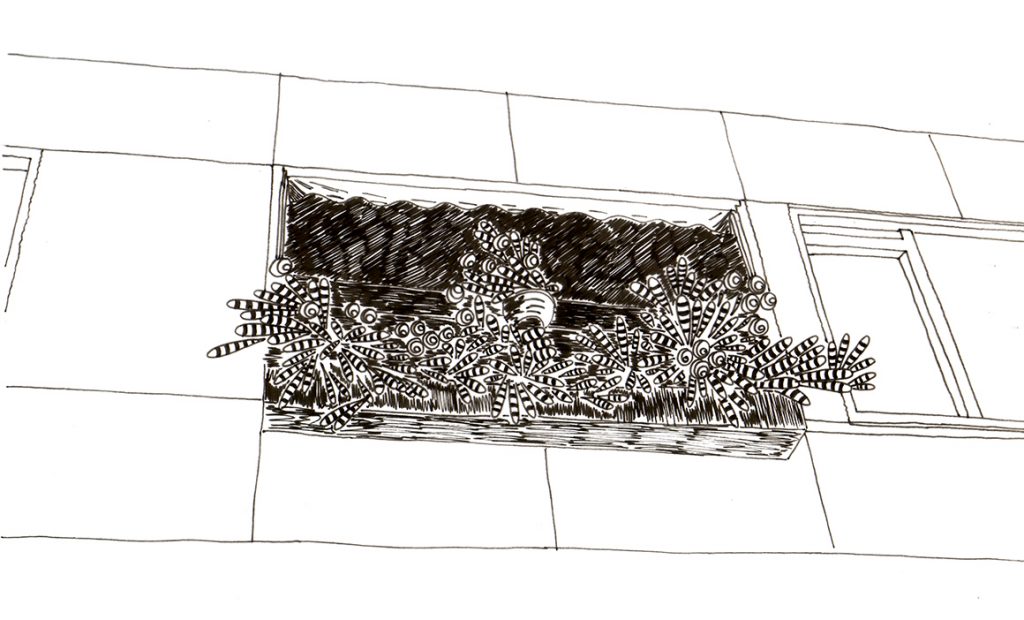
The role for city councils
Many city councils are in fact aware of all of this. In recent years there have been many initiatives to help city residents become better caretakers of their neighbourhoods. But here’s the issue. City councils are often slow-moving bodies, who tend to be quite reluctant to give away control. And when it takes too long for any neighbourhood initiative to get the permittance needed to get a project up and running, frustration sets in and promising ideas fall apart. City councils will have to treat residents with confidence, but this can only exist trough actual long-term collaboration between the municipality and the people. Financial support alone just won’t do.
So cities will have to change their roles. First of all, they would have to become quick facilitators. For example, when it comes to making locations suitable for citizen initiatives. Elements like paving and unattractive and uninviting looking green should speedily be removed. Also, licensing standards should be relaxed. The city should be more closely involved in the management and maintenance of project sites, by removing litter waste and installing irrigation, for instance. And for these projects to truly succeed we have to make clear agreements about who is responsible for which task.
More benefits
Yes, we have a way to go. But in case you’re still not sure about the unprecedented opportunities of active participation in urban nature; stick with us. If residents get the chance to enhance their environment, the environment wouldn’t be the only beneficiary. Greener neighbourhoods would mean more social cohesion between neighbours, especially if residents can take care of common spaces together. Furthermore, everybody knows that greener environments lead to a higher sense of well-being among citizens, makes people healthier and improves performances at work and in school. That’s old news, isn’t it?
That flowerpot again
So let’s get our hands dirty! And in case your city council still makes you wait, you now know what you can do yourself. Start with the first little step forward. Put that flowerpot outside your door. And give one to your neighbour too.

blog # 6 Agoraphobia, the fear of squares

by Nadine Roos
The image that pops up in my mind when I think of a square is of a place that is the nucleus in the urban life. Where chatting old man sit cosily on a bench. Hat on, the crooked legs somewhat apart and a walking stick in between. Tall stories are exchanged, they are laughing and still have a naughty look. Kids run around, playing tag. A group of teenagers lingers in the corner of the square, nonchalant and cool. Next to the fountain stands a couple in love. They only have eyes for each other. Neighbours meet in the middle of the square, they stop and exchange the latest news. In my imagination, this is a place for spontaneous meetings, of seeing and being seen. Also, the weather is always warm and sunny. Because I picture such a place in a Southern European country. Thinking of Dutch squares I think of empty, grey and stony areas.
Square-people
Why don’t Dutch squares have the same urban position as the Southern European ones? What’s the reason for this? And would it be possible to give the Dutch squares some of the Southern Joie de Vivre? I always thought it was a climate thing. If the weather over here would be just as lovely, our squares would be lively as well. Nevertheless, when the temperature rises above 20 degrees Celsius all Dutch people head out. The streets become busy, the terraces overflow but the squares remain empty. Are northerners no square-people? Or do squares have a different function in our perception? Or are Dutch squares designed in another manner and is that the reason why they are used differently.
Empty places
In the Netherlands, squares have a different function. Instead of places where the community comes together, they are just functional places. They are empty places that give room to the market and the fair. Dutch squares are emptier than the Southern squares. But people don’t like empty expenses. This is something that has to do with a pre-historical remnant. At an empty plain we feel exposed; in the event of an attack, there is no place to seek cover. Intuitively we don’t like walking on an empty square, let alone sit down and have a spontaneous chat with someone.

National character
Pragmatism is built in the Dutch DNA. A Dutch square is no-nonsense, without frills. The Dutch won’t feel an emotional closeness to a square. In the Mediterranean, squares provide in a connection with the local history. It´s the place for historical events and where they are commemorated. At many squares, you can find a statue of a someone who did amazing heroic deeds. A hero of whom everyone knows. In the Netherlands, you can also find bronze horses with a rider on its back. But I bet you that 99% of the Dutch, myself included, have no idea who is so proudly represented. Mediterranean squares are also places for traditional feasts. Celebrations that only are held in this particular city or region. This strengthens the square’s significance in the people’s perception.
Old men
Pragmatism is good. Problems get solved, things go smoothly and it avoids wastage. But pragmatism also needs a counterpart. Because life is not complete without feelings, attention and a little romance. The same is true about squares. Now too many Dutch squares are empty and holes in the urban fabric. They are places for acute agoraphobia, the fear of squares. For these squares, a binding identity is needed. A design that gives a sheltered feeling and that is inviting to stay. A couple of Dutch squares have made a step in the right direction. These are the squares with cafés and terraces. But staying at these squares is linked to a commercial activity. They are not inviting for everyone. And that something that they should be. Because when the sun breaks through, I want Dutch squares to be full of life and where you can find old men bragging and telling tall stories to each other.
